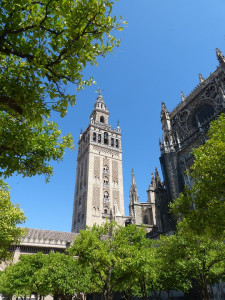The Cathedral, including the Giralda, was registered in 1987 as a World Heritage Site by UNESCO, along with the Alcázar and the General Archive of the Indies. The tower is 104.1 m in height and remains one of the most important symbols of the city, as it has been since the Middle Ages.
Initial construction
The mosque was built to replace the older Mosque of Ibn ‘Addabas, built in the 9th century under Umayyad rule, since the congregation had grown larger than that modest mosque could accommodate. It was commissioned in 1171 by caliph Abu Ya’qub Yusuf.
Sevillian architect Ahmad Ibn Baso, who had led other construction projects for the caliph, was in charge of designing the mosque. Construction was slowed down by the redirection of an existing city sewer that needed to be moved to accommodate the broad foundation for the building, an engineering obstacle that slowed progress by four years.
From the beginning, craftsmen from all over Al-Andalus and the Maghreb were enlisted in the mosque’s planning, construction, and decoration, and the caliph himself was highly invested in the process and was said to have visited the site daily. By 1176, the mosque was complete, save for the minaret; however, Friday prayer was not held there until 1182.
 Building of the Minaret
Building of the Minaret
Upon returning to al-Andalus in 1184 for a new military campaign, Aby Ya’qub Yusuf ordered the construction of the minaret. However, construction halted that same year with the death of the architect and, a month and a half later, the caliph, who died while commanding the Siege of Santarém.
His son, Abu Yusuf Yaqub al-Mansur, ordered construction on the minaret to continue upon his accession in 1184, but the work stalled again soon after and did not restart until 1188.
Ahmad Ibn Baso had begun the base of the tower in cut stone and his work was continued by a Maghrebi Berber architect named ‘Ali al-Ghumari, who was responsible for building the main body of the minaret in brick, and completed by Sicilian architect Abu Layth Al-Siqilli, who built the small secondary shaft at the top of the tower.
The minaret was built using both local bricks and recycled marble from old Umayyad monuments. On 10 March 1198, the tower was completed with the addition of the finial of four precious metal spheres at the tower’s peak to commemorate al-Mansur’s victory over Alfonso VIII of Castile, which had taken place four years prior.
The mosque
Before its partial destruction in a 1356 earthquake, the mosque was comparable in size to the great mosque of Cordoba and its walls faced the cardinal directions with mathematical preciseness. It had a rectangular floor plan measuring approximately 113 by 135 meters. The prayer hall was symmetrical and airy, with a still-extant courtyard, the Patio de los Naranjos, or “Courtyard of Orange Trees.” Its interior had a stucco-carved dome over the mihrab, as well as several matching carvings over the arched doorways.
The minbar was decorated in a Cordoban style, constructed from expensive wood and embellished with sandalwood, ivory, ebony, gold, and silver. The main northern entrance to the courtyard, the present-day Puerta del Perdón, contains a bronze-plated door with geometric decoration and floral knockers. The current knockers in place are replicas of the originals which are on display inside the Giralda tower.
The minaret
The minaret of the mosque still stands as the Giralda. The base at street level is a square of 13.6 m on the side and which sits on a solid foundation which is a bit wider, 15~16 m and about 5 m deep. The foundation is built with solid, rectangular stones, some taken and reused from the nearby walls of the former Abbadid palace and from the Roman city walls.
The tower consists of two sections: the main shaft and a much smaller second shaft, superimposed on top of it, which is enveloped today by the Renaissance-era belfry. The main shaft is 50.51 meters tall and the second shaft is 14.39 meters tall and has a square base measuring 6.83 meters.
The tower contains a series of 35 ramps winding around the perimeter of seven vaulted chambers at the tower’s core. These ramps were designed with enough width and height to accommodate “beasts of burden, people, and the custodians,” according to one chronicler from the era.


